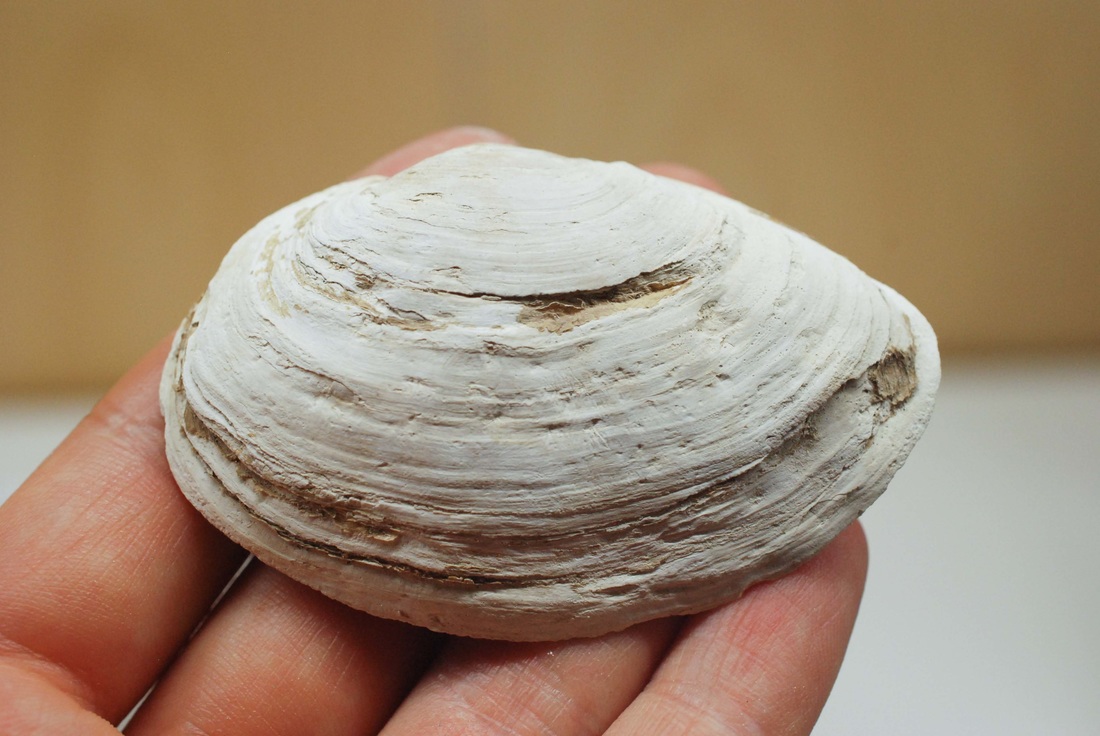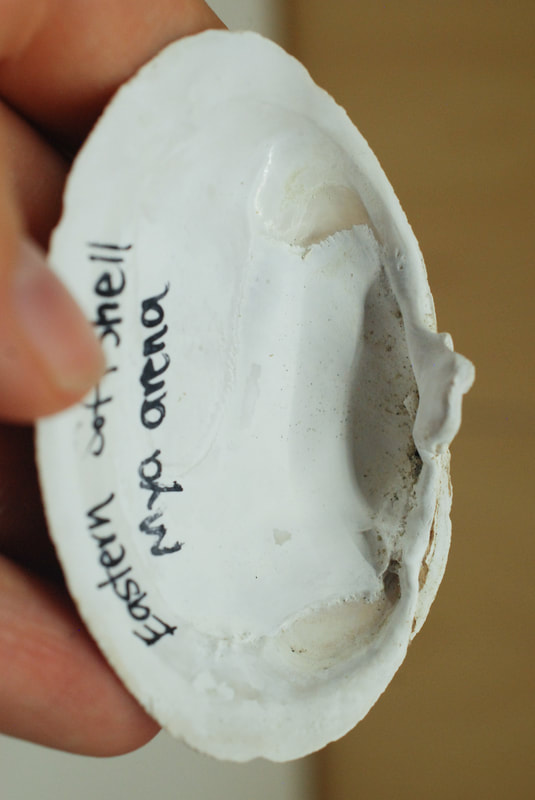Eastern soft-shell clam, mud clam, steamer clam • Mya arenaria
The left valve of an eastern soft-shell clam's shell. Note the chalky white exterior, the rough texture created by uneven concentric ribs, and the large chondrophore visible at the hinge on the right-hand image. Shell specimen from the bivalve collection at the Hakai Institute's Calvert Island field station. Photographed by Kelly Fretwell.
Identification
The eastern soft-shell clam has an elongated shell that is thin and brittle, with a grey or chalky white exterior, uneven concentric rings creating a rough texture, and brown to yellowish periostracum at the edges of the shell valves. A key identifying feature for softshell clams is the large spoon-shaped chondrophore, a hollowed-out projection located at the hinge of one of the shell valves (the left valve; click here for information on shell orientation). This clam has long dark siphons, and reaches 17 cm long.
Habitat & Range
This introduced clam buries 10-20 cm deep in mud or sandy mud in the intertidal and subtidal to 70 m or more, often in brackish and estuarine habitats. It is native to the east coast of North America, and has been introduced throughout much of the Northern Hemisphere. Its range on the west coast of North America extends from northern Alaska to central California. See the Global Invasive Species Database species page for detailed distribution information.
Human Uses
This species is commercially and recreationally harvested; the name "steamer clam" (or "steamers") comes from its popularity in clam bakes.
Intriguing Info
This species is thought have been unintentially introduced to North America in the 1800s, possibly when oyster stock was transported from the east coast of North America.
iNaturalist
https://www.inaturalist.org/taxa/81634-Mya-arenaria
The eastern soft-shell clam has an elongated shell that is thin and brittle, with a grey or chalky white exterior, uneven concentric rings creating a rough texture, and brown to yellowish periostracum at the edges of the shell valves. A key identifying feature for softshell clams is the large spoon-shaped chondrophore, a hollowed-out projection located at the hinge of one of the shell valves (the left valve; click here for information on shell orientation). This clam has long dark siphons, and reaches 17 cm long.
Habitat & Range
This introduced clam buries 10-20 cm deep in mud or sandy mud in the intertidal and subtidal to 70 m or more, often in brackish and estuarine habitats. It is native to the east coast of North America, and has been introduced throughout much of the Northern Hemisphere. Its range on the west coast of North America extends from northern Alaska to central California. See the Global Invasive Species Database species page for detailed distribution information.
Human Uses
This species is commercially and recreationally harvested; the name "steamer clam" (or "steamers") comes from its popularity in clam bakes.
Intriguing Info
This species is thought have been unintentially introduced to North America in the 1800s, possibly when oyster stock was transported from the east coast of North America.
iNaturalist
https://www.inaturalist.org/taxa/81634-Mya-arenaria
References
Cowles, D. (2014). Mya (Arenomya) arenaria Linnaeus, 1758. Invertebrates of the Salish Sea. Rosario Beach Marine Laboratory. Accessed 18/04/2018.
Global Invasive Species Database. (2018). Species profile: Mya arenaria. Accessed 18/04/2018.
Harbo, R. M. (1997) Shells & Shellfish of the Pacific Northwest. Madeira Park, BC: Harbour Publishing. P. 169.
Lamb, A., and Hanby, B. (2005). Marine Life of the Pacific Northwest [electronic version]. Madeira Park, BC: Harbour Publishing.
Authors and editors of page
Kelly Fretwell (2018).
Cowles, D. (2014). Mya (Arenomya) arenaria Linnaeus, 1758. Invertebrates of the Salish Sea. Rosario Beach Marine Laboratory. Accessed 18/04/2018.
Global Invasive Species Database. (2018). Species profile: Mya arenaria. Accessed 18/04/2018.
Harbo, R. M. (1997) Shells & Shellfish of the Pacific Northwest. Madeira Park, BC: Harbour Publishing. P. 169.
Lamb, A., and Hanby, B. (2005). Marine Life of the Pacific Northwest [electronic version]. Madeira Park, BC: Harbour Publishing.
Authors and editors of page
Kelly Fretwell (2018).






